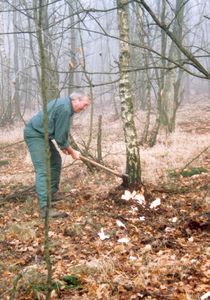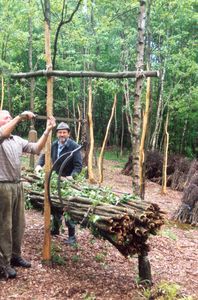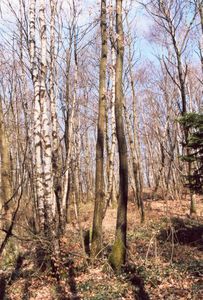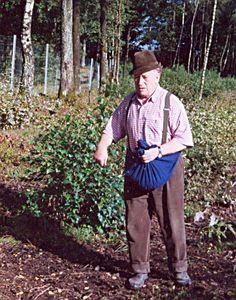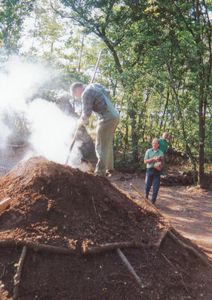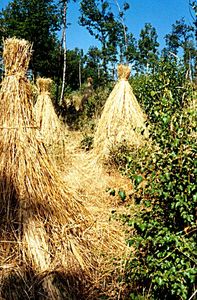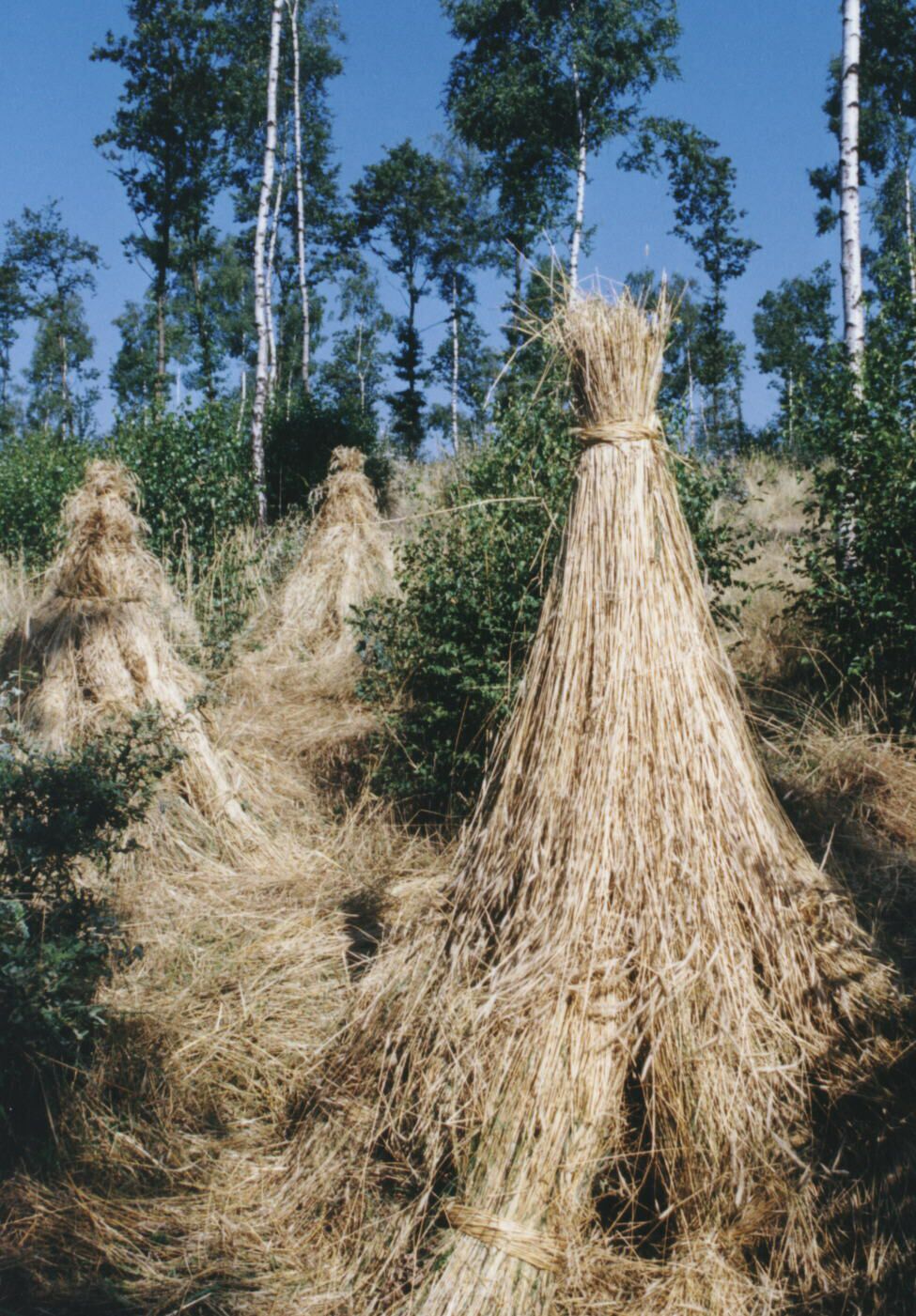
In the year of the chopping down, the remaining vegetation and leaf litter are removed, dried, and burned. Afterwards, either rye in the autumn or buckwheat in June are sown and harvested in August of the following or October of the same year, respectively.
After a grace period of five to seven years, for a period of seven to eleven, on average nine years, livestock (cattle or sheep) were driven to pasture in the Hauberg. Then followed the new chopping.
All activities in the Hauberg were temporally and factually tuned. For example, the removal of brushwood for fuel purposes prepard the ground for the agricultural interim use. The production of tanbark at the time of greatest activity of the oak's cambium can be completed just in time so that the oak can sprout anew from the roots and form viable shoots.
Another important feature of Haubergs is that the forest property is jointly owned by the inhabitants of the village who also manage the Hauberg together. The shareholders are a Haubergsgenossenschaft with a board and a chairman of the board, the so-called Haubergs- or Waldvorsteher (forest principal).
Thus the Hauberg, in addition to the singualar characteristics of the economy, has other peculiarities of tree species composition, of the multiple resource usage, the form of ownership, and management of the community. All these features have historical roots.
To classify the Haubergs in other forms of low-forestry see HABERKERN-WALLACH (1974) und BECKER (1995).
Jung Stilling
A graphic account of the classical Haubergswirtschaft is presented by Johann Heinrich Jung, called Jung-Stilling, who was born in 1740 in Grund near Hilchenbach and later a professor of cameralistics in Kaiserslautern, Heidelberg and Marburg. He wrote in 1775:
"As soon as the weather is bearable and the ground is bare, which commonly happens in April, they begin to clear. This is done in the following fashion. They have heavy knifes with wooden sticks, which they call a Heppe, on the tip of which protrudes a beak which protects the instrument so that they may not cut so easily into earth and stones, it has many similarities with the knife, which the coopers generally have stuck in their leather apron. With this tool every one goes into the copse, seek his Jahn (so they call the divided areas of the bushes), and then they cut out all trees, which are not thicker than a thumb's width, along with the branches of larger trees, if they can achieve the same, clean and bare. This brushwood they bind in bundles or sheaves together, put them in barns or shanties, and let it dry out, and this provides them with their annual supply of firewood, with which they supply kitchens and ovens. In May they start the cutting down, every one hews all thick wood cleanly off. The remaining branches they cut off and also scatter it on the Jahn, but the trunks they put on heaps, and in the autumn burn it to coals. In June thy hack the sod, every one on his Jahn, sothat at the end of the month the ground is layed bare. In July, in between the hay harvest, they shift the sods with iron Krapen (some kind of harrow) so they can dry on both sides. In August, they put the dried-up twigs on small clusters, pull the grass on these piles of wood, so that all the grass will be moved from the earth on to the wood, but they always turn the openening of the mounds to the wind so that the wood or sticks just stand out in front. Then they set fire to any grass pile, and the whole copse smoketh as if on fire, and so they burn all the grass into tiny ashes. These ashes in September will be dispersed with iron shovels so that they are evenly distributed; afterwards every man sows rye on his Jahn, which prospers in these hills year in, year out, except that the straw never achieves the strength of the field straw. This seed will soon, when the grain is sown, be hoen under with large iron hooks that have the form of such a T, and are pulled by oxen, so that it is thinly covered with earth and ashes. When the grain is reaped the following year, the copse lays quiet the next sixteen years. The soil is now fertilized by the ashes, the root sprout the fattest shoots, and within six to seven years the brush is again so dense that one can hardly walk through it, and after sixteen years the trunks have the the thickness of an arm or a man's thigh. But also grass and herbs grow in abundance on the ground; thus such a copse will be rested only three to four years, but afterwards they graze their cattle freely and without any harm in it. The residents have use of such a copse every year to take wood and bread fruit, without having to fear loss."
Another use of the Hauberg is not mentionioned by Jung-Stilling, namely production of tanbark, the extraction of oak bark for tanning. This is probably not a coincidence.Most likely, the tanbark production in the Hauberg has only been widely done from nineteenth century on.
(From Alfred Becker, Der Siegerländer Hauberg, © 1991 Verlag die Wielandschmiede, revised 2000, translated 2012)
